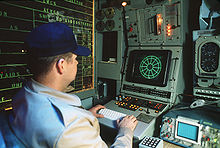AN / SLQ-32
The AN / SLQ-32 is a ship-based system for electronic warfare . It is produced by the US company Raytheon and is used on a large number of American warships .
development
The development of the AN / SLQ-32 was a response to the sinking of the Israeli destroyer Eilat by an anti-ship missiles of the type SS-N-2 Styx during the six-day war . It was recognized that a totally unprotected ship like the Eliat was highly vulnerable to anti- ship attack. Further analyzes showed that the existing systems AN / WLR-1 and AN / ULQ-6 no longer offered adequate protection. The development of the system was authorized by the US Navy in 1972 . In 1977 Raytheon was entrusted with the production of the AN / SLQ-32 (V). The last tests then took place in July 1977 on board the USS Oliver Hazard Perry . In order to keep pace with the ongoing development, all systems were extensively upgraded from 1987 within the scope of the "Electronic Warfare Improvement Program" (EWIP). This upgrade makes the SLQ-32 an integral part of the Ship Self Defense System and has been designated as the AN / SLQ-32A . The computer systems were also continuously modernized, with the last major software update being carried out in 1998.
technology

The SLQ-32 was planned as a simple warning and classification system. To this end, several receiving units were distributed on the ship to ensure 360 ° coverage. If the system detects an active radar source, it is classified and displayed with additional data on the operator terminal screen. At the same time, SRBOC countermeasures can be triggered and CIWS systems can be supplied with target data.
Since the (V) 3 variant, electronic countermeasures can also be carried out. The corresponding transmitters all have their own traveling wave tube ("TWT") with a relatively low transmission power. 32 individual signal cones are generated per 90 ° sector, which together achieve a radiation power of up to 1 MW. The system has a wide range of operating modes ( continuous wave , impulse, spoofing, etc.) in order to be able to react effectively to modern threats with high ECCM capacities. Up to 75 radar emitters of each type can be disrupted in parallel using individual techniques.
variants
- AN / SLQ-32 (V) 1: Provides warning, detection and tracking of approaching, radar-guided anti-ship missiles. Monitoring in the range 8–20 GHz.
- AN / SLQ-32 (V) 2: In this variant, SIGINT properties have been added so that the target radars of enemy ships can now be captured and identified before they fire their guided missiles. The frequency range has also been expanded (1-20 GHz).
- AN / SLQ-32 (V) 3: This version offers a variety of electronic countermeasures in the 8–20 GHz frequency range.
- AN / SLQ-32 (V) 4: This is an adapted system for aircraft carriers (two systems are used in a network). The maximum radiation output is approx. 1 MW.
- AN / SLQ-32 (V) 5: Upgraded version that equips ships that originally used the (V) 2 variant with electronic countermeasures.
commitment

Because the SLQ-32 is installed on many American warships, it has been used in virtually every conflict since 1980. Of particular note, however, was an incident during Operation Earnest Will in the Persian Gulf in 1987. On May 17, an Iraqi Mirage F-1 fired two Exocet anti-ship missiles at the frigate USS Stark . The integrated AN / SLQ-32 (V) 2 was able to detect the attack, but had no electronic countermeasures and so both missiles hit the ship. As a result of this incident, the “Sidekick” system was developed which equips ships with the (V) 2 variant with active electronic countermeasures. This version is referred to as AN / SLQ-32 (V) 5.
future
Originally, the SLQ-32 was to be replaced by the "Advanced Integrated Electronic Warfare System" (AIEWS). This system was named AN / SLY-2 and reached the prototype stage in 1999 . However, the development and financing was stopped in 2002 due to sharply rising costs. General Dynamics is currently working on an extensive upgrade for the existing SLQ-32 systems, the "Surface Electronic Warfare Improvement Program" (SEWIP). The program consists of several expansion stages ("blocks"): Block 1A modernizes the displays and the interface, Block 1B1 replaces some outdated electronic components, Block 1B2 and 1B3 replace parts of the receiver system. In March 2009, the US Navy placed the order to begin series production of Block 1B2.
Platforms
Note: This list is based on data from 1998. In the meantime, many ships that were originally equipped with the (V) 2 variant have been modernized to the (V) 3 or (V) 5 standard.
- AN / SLQ (V) 1: Anchorage Class , Harpers Ferry Class , Whidbey Island Class
- AN / SLQ (V) 2: Arleigh Burke class , Oliver Hazard Perry class , Spruance class
- AN / SLQ (V) 3: Arleigh Burke Class , Iwo Jima Class , Kidd Class , Sacramento Class , Spruance Class , Supply Class , Tarawa Class , Ticonderoga Class , Wasp Class
- AN / SLQ (V) 4: Kitty Hawk Class , Nimitz Class , USS Enterprise (CVN 65)
- AN / SLQ (V) 5: Oliver Hazard Perry class
Web links
- FAS.org
- The Warfighter Encyclopedia ( Memento from September 20, 2006 in the Internet Archive )
- Manufacturer's brochure (PDF; 1019 kB) ( Memento from March 18, 2006 in the Internet Archive ) (English)
